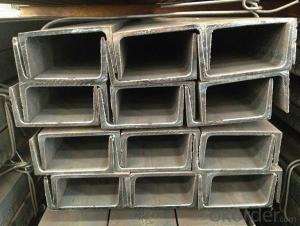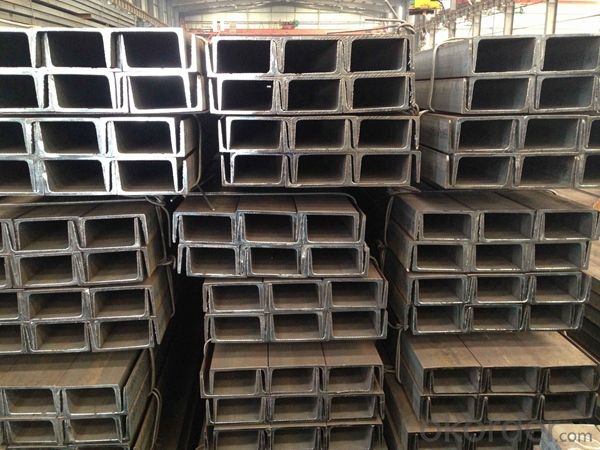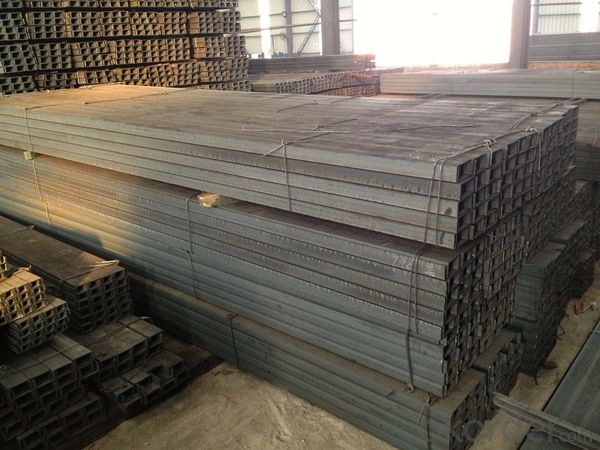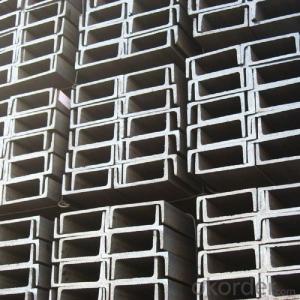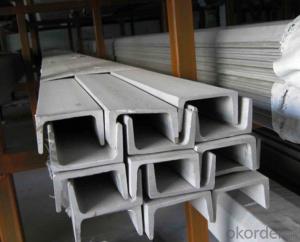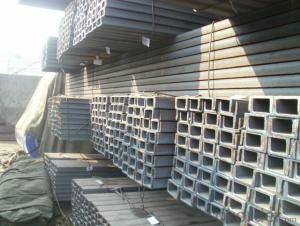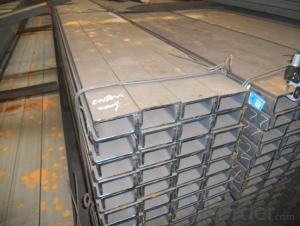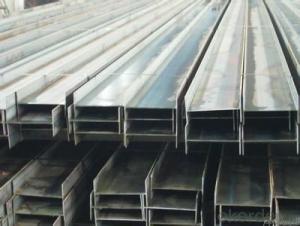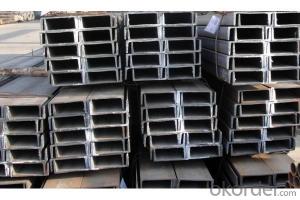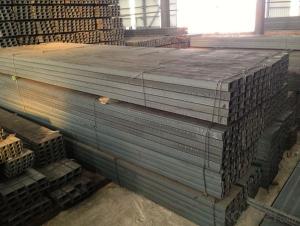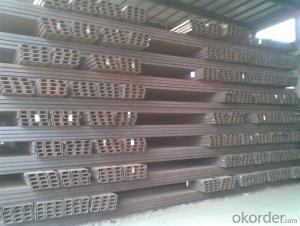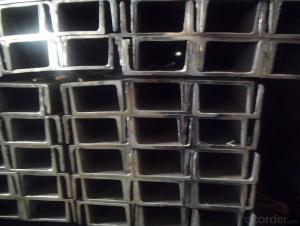Hot Rolled Steel U Channels beams for Construction of Warehouses
- Loading Port:
- Tianjin
- Payment Terms:
- TT OR LC
- Min Order Qty:
- 25 m.t.
- Supply Capability:
- 200000 m.t./month
OKorder Service Pledge
OKorder Financial Service
You Might Also Like
Product Description:
OKorder is offering Hot Rolled Steel U Channels beams for Construction of Warehouses at great prices with worldwide shipping. Our supplier is a world-class manufacturer of steel, with our products utilized the world over. OKorder annually supplies products to European, North American and Asian markets. We provide quotations within 24 hours of receiving an inquiry and guarantee competitive prices.
Product Applications:
Hot Rolled Steel U Channels beams for Construction of Warehouses are ideal for structural applications and general fabricating. The steel u channel can be applied to construction of warehouses, workshops, sport stadiums and car parks etc. In details, the steel u channel belongs to carbon structural steel which is applied to in the field of construction and machinery. The steel u channel is usually used for arch-itechtural structure, and they could be welded in order to support or hang a vari-ety of facilities. They are also usually used in combination with I beam. Generally,the steel u channel must possess perfect welding property, riveting property and mechanical property and so on.
Product Advantages:
Hot Rolled Steel U Channels beams for Construction of Warehouses are durable, strong, and resists corrosion.
Main Product Features:
· Premium quality
· Prompt delivery & seaworthy packing (7-10 days after receiving deposit)
· Corrosion resistance
· Can be recycled and reused
· Mill test certification
· Professional Service
· Competitive pricing
Product Specifications:
1.We supply high quality MS Channel at reasonable price, including Chinese standard, Japanese standard and so on.
Standard | GB/JIS |
Material Grade | Q235,SS400 |
Technique: | Hot Rolled |
Sizes as per chinese standard: | 50*37*4.5mm - 300*89*11.5mm |
Sizes as per japanese standard: | 50*25*3mm – 200*80*7.5mm |
Length: | 6meter, 9meter, 12meter |
Note: 1.we are also competent to provide our customers other MS Channel based on other sizes according to customer’s requirements.
2. The length of our ms channel could be cut into other meters as per customer’s requirements. For example, the channel in 6meters could be cut into 5.8meters in order to be fit in the 20ft container.
2. The detailed sections of MS Channel as per GB standard.are shown in the table-1:
GB U CHANNEL | Standard | Sectional | Dimension |
| Mass: |
(mm) | (mm) | (mm) | (mm) | ||
50X37 | 50 | 37 | 4.50 | 7.0 | 5.438 |
63X40 | 63 | 40 | 4.80 | 7.5 | 6.634 |
80x43 | 80 | 43 | 5.00 | 8.0 | 8.045 |
100x48 | 100 | 48 | 5.30 | 8.5 | 10.007 |
120x53 | 120 | 53 | 5.50 | 9.0 | 12.059 |
140x58 | 140 | 58 | 6.00 | 9.5 | 14.535 |
140x60 | 140 | 60 | 8.00 | 9.5 | 16.733 |
160x63 | 160 | 63 | 6.50 | 10.0 | 17.240 |
160x65 | 160 | 65 | 8.50 | 10.0 | 19.752 |
180x68 | 180 | 68 | 7.00 | 10.5 | 20.174 |
180x70 | 180 | 70 | 9.00 | 10.5 | 23.000 |
200x73 | 200 | 73 | 7.00 | 11.0 | 22.637 |
200x75 | 200 | 75 | 9.00 | 11.0 | 25.777 |
220x77 | 220 | 77 | 7.00 | 11.5 | 24.999 |
220x79 | 220 | 79 | 9.00 | 11.5 | 28.453 |
250x78 | 250 | 78 | 7.00 | 12.0 | 27.410 |
250x80 | 250 | 80 | 9.00 | 12.0 | 31.335 |
250x82 | 250 | 82 | 11.00 | 12.0 | 35.260 |
280x82 | 280 | 82 | 7.50 | 12.5 | 31.427 |
280x84 | 280 | 84 | 9.50 | 12.5 | 35.823 |
280x86 | 280 | 86 | 11.50 | 12.5 | 40.219 |
300x85 | 300 | 85 | 7.50 | 13.5 | 34.463 |
300x87 | 300 | 87 | 9.50 | 13.5 | 39.173 |
300x89 | 300 | 89 | 11.50 | 13.5 | 43.883 |
Table-1
3. The chemical composition of HR Channel Steel according to Q235B is shown in Table-2.
Alloy No | Grade | Element(%) | ||||
C | Mn | S | P | Si | ||
Q235 | B | 0.12-0.20 | 0.3-0.7 | ≦0.045 | ≦0.045 | ≦0.3 |
Table-2
Note: we are able to present our customers relevant SGS test report for chemical composition of HR Channel Steel.
4. The mechanical property of HR Channel Steel according to Q235B is shown in Table-3-1 and Table-3-2
Alloy No | Grade | Yielding Strength Point(Mpa) | |||
Thickness(mm) | |||||
≦16 | >16-40 | >40-60 | >60-100 | ||
≧ | |||||
Q235 | B | 235 | 225 | 215 | 205 |
Table-3-1
Alloy No | Grade | Tensile Strength(Mpa) | Elongation After Fracture(%) | |||
Thickness(mm) | ||||||
≦16 | >16-40 | >40-60 | >60-100 | |||
≧ | ||||||
G235 | B | 375-500 | 26 | 25 | 24 | 23 |
Table-3-2
Note: we are able to present our customers relevant SGS test report for mechanical property of MS Channel as customer’s request.
FAQ:
Q1: Why buy Hot Rolled Steel U Channels beams for Construction of Warehouses from OKorder.com?
A1: All products offered byOKorder.com are carefully selected from China's most reliable manufacturing enterprises. Through its ISO certifications, OKorder.com adheres to the highest standards and a commitment to supply chain safety and customer satisfaction.
Q2: How do we guarantee the quality of our products?
A2: We have established an advanced quality management system which conducts strict quality tests at every step, from raw materials to the final product. At the same time, we provide extensive follow-up service assurances as required.
Q3: How soon can we receive the product after purchase?
A3: Within three days of placing an order, we will begin production. The specific shipping date is dependent upon international and government factors, but is typically 7 to 10 workdays.
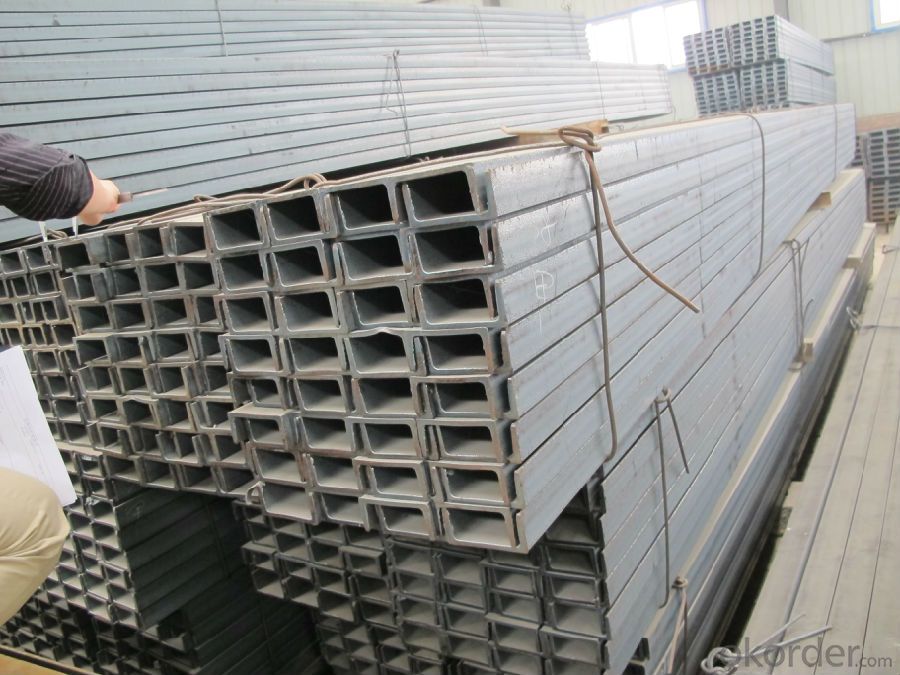
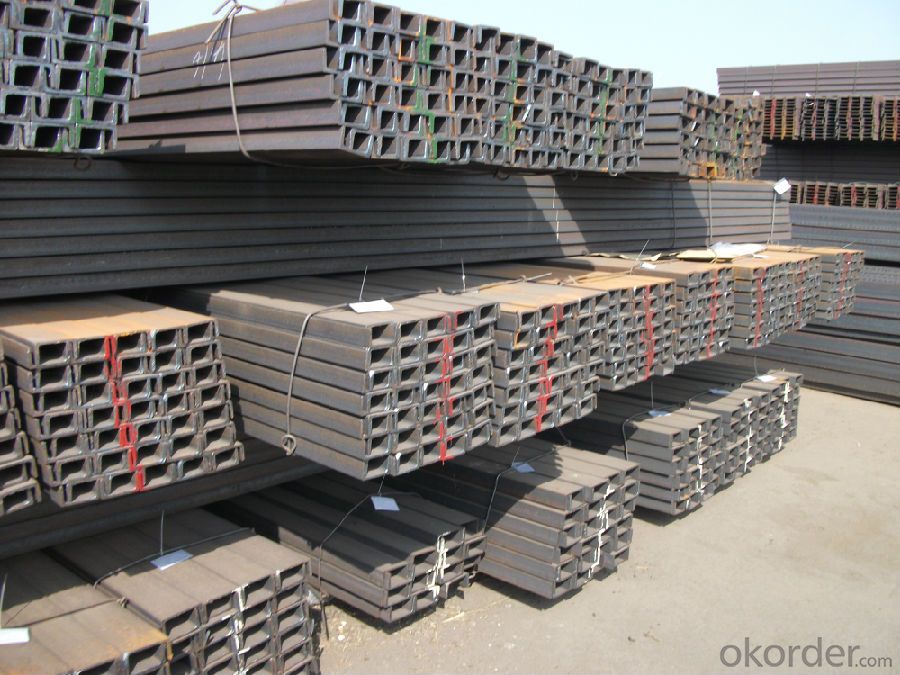
- Q: Are steel channels suitable for use in industrial shelving?
- Yes, steel channels are highly suitable for use in industrial shelving due to their durability, strength, and ability to support heavy loads. Steel channels provide structural stability and can withstand the demands of an industrial environment, making them an ideal choice for shelving systems that need to withstand rigorous use and heavy-duty storage requirements.
- Q: What are the different methods for designing steel channels for high wind loads?
- There are several methods for designing steel channels to withstand high wind loads. Some of the commonly used methods include: 1. Load and Resistance Factor Design (LRFD): This method uses a combination of load factors and resistance factors to determine the required strength of the steel channels. The loads are calculated based on the wind speed and the dimensions of the building, while the resistance factors are based on the material properties and safety factors. 2. Allowable Stress Design (ASD): In this method, the wind loads are converted into equivalent static loads and compared to the allowable stresses of the steel channels. The allowable stresses are determined by considering factors such as material properties, safety factors, and load combinations. 3. Wind Tunnel Testing: Wind tunnel testing involves constructing a scaled-down model of the building and subjecting it to simulated wind conditions. This allows engineers to analyze the airflow patterns and measure the forces acting on the steel channels. The data obtained from wind tunnel testing can be used to refine the design and optimize the steel channel dimensions. 4. Finite Element Analysis (FEA): FEA is a numerical method that allows engineers to simulate the behavior of steel channels under different wind loads. By dividing the structure into small elements and applying appropriate boundary conditions, FEA can accurately calculate the stresses, deformations, and displacements in the steel channels. This enables engineers to optimize the design and identify areas of high stress concentration that may require reinforcement. 5. Prescriptive Design Codes: Many countries have specific design codes and standards that provide guidelines for designing steel channels for high wind loads. These codes outline the minimum requirements for factors such as channel dimensions, material properties, connections, and fasteners. Following these codes ensures that the steel channels are designed to withstand the expected wind loads. It is important to note that the choice of design method may vary depending on factors such as the complexity of the structure, the available resources, and the specific requirements of the project. Consulting with a structural engineer experienced in designing for high wind loads is recommended to ensure a safe and efficient design.
- Q: Can steel channels be used for supporting rooftop solar arrays?
- Yes, steel channels can be used for supporting rooftop solar arrays. Steel channels provide strength, durability, and stability, making them suitable for bearing the weight of solar panels and withstanding various environmental conditions. Additionally, steel channels can be easily installed and adjusted to accommodate the specific requirements and layout of a rooftop solar array.
- Q: What kind of high strength steel and square steel
- Square is a square,,Channel steel is irregularly shaped. Groove geometry must be of the same thickness to compare.Material as long as the material is the same, the intensity is the same.The channel is formed by the steel rolling.
- Q: Can steel channels be used for elevator shafts?
- Yes, steel channels can be used for elevator shafts. Steel channels, which are structural components made of steel in a "C" shape, are commonly used in construction for various purposes, including elevator shafts. Steel channels provide strength, stability, and support to the elevator shaft structure, ensuring its ability to withstand the weight and load of the elevator car, as well as any additional loads such as people or heavy equipment. Additionally, steel channels can be easily fabricated and customized to fit the specific requirements of the elevator shaft, making them a suitable choice for this application.
- Q: Can steel channels be used for equipment enclosures?
- Yes, steel channels can be used for equipment enclosures. Steel channels are structural components that are typically used to provide support and stability to various structures, including equipment enclosures. They are made from strong and durable steel materials, which make them ideal for protecting equipment from external elements and potential damage. Steel channels can be easily customized and fabricated to fit the specific dimensions and requirements of the equipment enclosure. Additionally, steel channels can also be further reinforced with additional steel components to enhance the overall strength and security of the enclosure. Overall, steel channels provide a reliable and robust solution for constructing equipment enclosures.
- Q: How do steel channels perform in earthquake-prone areas?
- Steel channels perform well in earthquake-prone areas due to their high strength and ductility. They can effectively absorb and distribute seismic forces, providing enhanced resistance to structural damage. Additionally, steel channels can be designed to flex and bend during an earthquake, minimizing the risk of collapse and ensuring the safety of buildings and structures in these regions.
- Q: What is the standard length of steel channels?
- The standard length of steel channels can vary depending on the manufacturer and specific requirements but it is commonly available in lengths of 20 feet (6.1 meters) or 40 feet (12.2 meters).
- Q: For example, channel 8 is bent into a circle with an inner diameter of 1030 and an opening outwards. How do you calculate the lofting length?
- Divide the line 16 from 0.1.2.3 to 16. Calculate the two diameter elbow lofting: Yn=r cos alpha when 0 DEG n below 90 DEG Yn=1/2 alpha (d-2t alpha) cosWhen 90 degrees less than or equal to 180 degrees when n < alpha Yn=1/2dcos alphaIn the formula, the Yn--- expansion graph has a circumferential length equal to the curve coordinate value;R--- auxiliary circle radius;D--- diameter of round tube;T--- plate thickness;Alpha n--- auxiliary circumferential equal angle; tube of 300mm diameter,N optional 16 alpha 1=360 degrees, /16=22.5 degrees, 2=45 degrees, 3=67.5 degrees, 4=90 degrees, 5=112.5 degrees, 6=135 degrees, 7=157.5 degrees, 8=180 degreesFormula: Y0=1/2 (d-2t) cos0 degrees =0.5 (d-2t)Y1=1/2 (d-2t) cos22.5 degrees =0.4619 (d-2t)Y2=1/2 (d-2t) cos45 degrees =0.3536 (d-2t)Y3=1/2 (d-2t) cos67.5 degrees =0.1913 (d-2t)Y4=1/2 (d-2t) cos90 degrees =0Y5=1/2 dcos112.5 degrees =-0.1913dY6=1/2 dcos135 degrees =-0.3536dY7=1/2 dcos157.5 degrees =-0.4619dY8=1/2 dcos180 degrees =-0.5d
- Q: Channel 10, 6 meters long, two ends fixed, how much weight can the middle bear?
- Under the maximum bending moment calculation formula: M=1/8GL?? -1/8gL??, (L=600cm, G: the calculation of the maximum uniform load, G: ibid.)
Send your message to us
Hot Rolled Steel U Channels beams for Construction of Warehouses
- Loading Port:
- Tianjin
- Payment Terms:
- TT OR LC
- Min Order Qty:
- 25 m.t.
- Supply Capability:
- 200000 m.t./month
OKorder Service Pledge
OKorder Financial Service
Similar products
Hot products
Hot Searches
Related keywords
